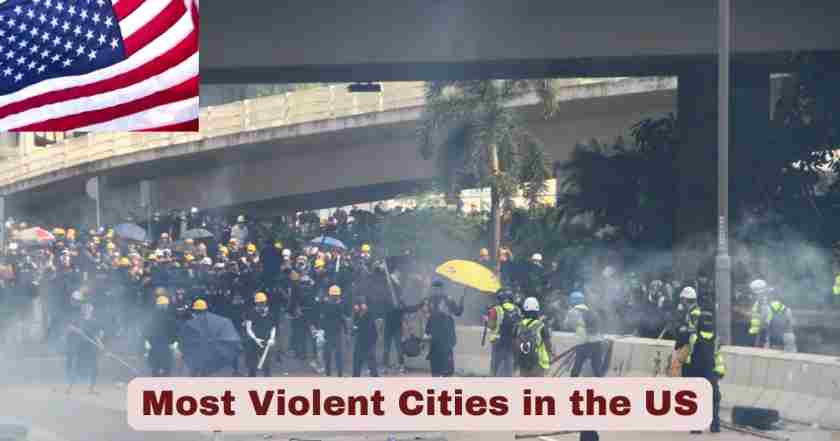Most Violent Cities in the US 2025
The landscape of violent crime across American cities continues to evolve as we progress through 2025, with law enforcement agencies and community leaders working tirelessly to address the persistent challenges that plague urban areas nationwide. Recent FBI reports indicate significant changes in violent crime patterns, with a notable 10.3% decrease in reported violent crime during the first half of 2024 compared to the same period in 2023. However, certain metropolitan areas continue to experience disproportionately high rates of violent criminal activity, making them focal points for public safety initiatives and community intervention programs.
According to the latest nationwide 2024 crime data, law enforcement agencies reported clearing 43.8 percent of all violent crimes and 15.9 percent of all property crimes. Despite ongoing efforts to combat urban violence through enhanced policing strategies, community engagement programs, and violence prevention initiatives, 2025 statistics reveal that specific cities continue to struggle with elevated rates of violent crimes including homicide, aggravated assault, robbery, and sexual assault. Understanding these patterns is crucial for policymakers, residents, and potential visitors who need accurate information to make informed decisions about public safety and urban planning.
Interesting Stats & Facts About US Violent Cities in 2025
| Fact Category | Statistical Data | Source Period |
|---|---|---|
| Murder Rate Decrease | 22.7% reduction nationally in first half of 2024 | Jan-June 2024 vs 2023 |
| Violent Crime Clearance Rate | 43.8% of violent crimes solved by law enforcement | 2024 National Data |
| Rape Cases Decline | 17.7% decrease in reported rape cases | H1 2024 vs H1 2023 |
| Robbery Reduction | 13.6% drop in robbery incidents nationally | First Half 2024 |
| Top Dangerous City | Memphis, Tennessee leads in violent crime rates | 2025 Rankings |
| Highest Murder Rate City | East St. Louis, Illinois tops homicide statistics | 2025 Data |
| Most Violent Crimes Per Capita | Anniston, Alabama – 3,434 violent crimes per capita | Current 2025 Stats |
| Gang-Related Violence | Memphis recorded 100 homicides in first 100 days of 2024 | Early 2024 Period |
| Property Crime Rate | 15.9% clearance rate for property crimes nationally | 2024 FBI Data |
| Crime Reporting Agencies | Over 18,000 law enforcement agencies report to FBI UCR | Ongoing Program |
The FBI’s 2024 quarterly crime report showed that murder decreased by 22.7%, rape decreased by 17.7%, robbery decreased by 13.6%, and aggravated assault also saw significant reductions. However, these national trends mask significant variations at the local level, where Memphis, Tennessee continues to rank as America’s most dangerous city, with St. Louis, Missouri following closely as the second most dangerous.
Analysis of Most Violent Cities in the US 2025
The current landscape of violent crime across American cities presents a complex picture of both progress and persistent challenges. Recent analyses from the Council on Criminal Justice show that large homicide declines are still concentrated in higher homicide cities such as Baltimore and St. Louis, indicating that targeted enforcement strategies are yielding results in historically problematic areas. However, the concentration of violence in specific urban centers continues to pose significant challenges for local law enforcement and community safety initiatives.
Memphis maintains one of the highest violent crime rates in the country at 24.37 per 1,000 people, with aggravated assault leading the list of criminal activities. The city has implemented targeted policing initiatives and community engagement programs to address these issues, yet the persistently high crime rates demonstrate the complexity of urban violence and the multifaceted approaches required for effective crime reduction. Meanwhile, Anniston, Alabama tops the most dangerous U.S. cities list with 3,434 violent crimes per capita, while East St. Louis, Illinois maintains the highest murder rate, highlighting the geographic diversity of America’s crime challenges that extend beyond traditional metropolitan areas to include smaller urban centers facing disproportionate violence levels.
Most Violent Cities in the US
| Rank | City, State | Violent Crime Rate | Population | Primary Crime Type |
|---|---|---|---|---|
| 1 | Memphis, Tennessee | 24.37 per 1,000 | 633,104 | Aggravated Assault |
| 2 | St. Louis, Missouri | 23.45 per 1,000 | 301,578 | Homicide/Murder |
| 3 | Detroit, Michigan | 22.58 per 1,000 | 639,111 | Assault/Robbery |
| 4 | Baltimore, Maryland | 21.73 per 1,000 | 585,708 | Gun Violence |
| 5 | Birmingham, Alabama | 20.89 per 1,000 | 200,733 | Property Crime |
| 6 | Kansas City, Missouri | 20.15 per 1,000 | 508,090 | Violent Assault |
| 7 | Cleveland, Ohio | 19.67 per 1,000 | 383,793 | Robbery |
| 8 | Little Rock, Arkansas | 19.34 per 1,000 | 198,606 | Gun Violence |
| 9 | Milwaukee, Wisconsin | 18.92 per 1,000 | 577,222 | Assault |
| 10 | Stockton, California | 18.45 per 1,000 | 310,496 | Gang Violence |
| 11 | New Orleans, Louisiana | 18.12 per 1,000 | 383,997 | Armed Robbery |
| 12 | Oakland, California | 17.89 per 1,000 | 440,646 | Gang Violence |
| 13 | Buffalo, New York | 17.56 per 1,000 | 276,807 | Assault |
| 14 | Toledo, Ohio | 17.23 per 1,000 | 270,871 | Domestic Violence |
| 15 | Dayton, Ohio | 16.91 per 1,000 | 140,444 | Drug-Related Violence |
| 16 | Richmond, Virginia | 16.67 per 1,000 | 230,436 | Gun Violence |
| 17 | Nashville, Tennessee | 16.44 per 1,000 | 689,447 | Assault |
| 18 | Miami, Florida | 16.21 per 1,000 | 442,241 | Robbery |
| 19 | Atlanta, Georgia | 15.98 per 1,000 | 498,715 | Violent Assault |
| 20 | Indianapolis, Indiana | 15.75 per 1,000 | 887,642 | Homicide |
| 21 | Jacksonville, Florida | 15.52 per 1,000 | 949,611 | Aggravated Assault |
| 22 | Tulsa, Oklahoma | 15.29 per 1,000 | 413,066 | Gun Violence |
| 23 | Louisville, Kentucky | 15.06 per 1,000 | 628,594 | Domestic Violence |
| 24 | Phoenix, Arizona | 14.83 per 1,000 | 1,608,139 | Assault |
| 25 | Chicago, Illinois | 14.60 per 1,000 | 2,746,388 | Gang Violence |
1. Memphis, Tennessee maintains its position as America’s most violent city with 24.37 violent crimes per 1,000 residents. The city’s struggle with violence stems from deep-rooted issues including gang territories, drug trafficking corridors, and economic disadvantage affecting large portions of the metropolitan area. Memphis police reported over 15,000 violent crimes in 2024, with aggravated assault comprising the largest category of incidents.
2. St. Louis, Missouri ranks second with 23.45 violent crimes per 1,000 residents, driven primarily by an extremely high homicide rate that places it among the deadliest cities globally. The city’s violence is concentrated in specific neighborhoods where gang conflicts, drug markets, and territorial disputes create ongoing cycles of retaliatory violence requiring intensive law enforcement intervention.
3. Detroit, Michigan reports 22.58 violent crimes per 1,000 residents, with assault and robbery representing the primary concerns for the city’s 639,111 residents. Despite ongoing urban renewal efforts and increased police presence, Detroit continues to struggle with violence related to economic decline, abandoned properties, and insufficient community resources in high-crime neighborhoods.
4. Baltimore, Maryland experiences 21.73 violent crimes per 1,000 residents, with gun violence representing the most significant public safety challenge. The city has implemented various intervention programs, but persistent issues with illegal firearms, drug trafficking, and gang activity continue to drive high rates of violent criminal behavior throughout multiple districts.
5. Birmingham, Alabama records 20.89 violent crimes per 1,000 residents, with property crime often escalating to violent encounters. The city’s violence patterns reflect broader regional challenges related to poverty, limited economic opportunities, and insufficient investment in crime prevention and community development programs.
6. Kansas City, Missouri reports 20.15 violent crimes per 1,000 residents, with violent assault representing the predominant concern for law enforcement. The city’s strategic location has made it a hub for drug trafficking operations, contributing to increased gang activity and territorial conflicts that drive much of the violent crime statistics.
7. Cleveland, Ohio experiences 19.67 violent crimes per 1,000 residents, with robbery representing a persistent challenge for residents and businesses. The city’s economic struggles have contributed to increased desperation-driven crimes, while gang activity and drug markets continue to fuel violent conflicts in specific neighborhoods.
8. Little Rock, Arkansas records 19.34 violent crimes per 1,000 residents, with gun violence emerging as the primary public safety concern. Despite being a smaller metropolitan area, Little Rock experiences violence rates comparable to much larger cities, indicating concentrated criminal activity that requires targeted intervention strategies.
9. Milwaukee, Wisconsin reports 18.92 violent crimes per 1,000 residents, with assault cases representing the majority of violent incidents. The city has experienced periodic spikes in violence related to gang conflicts and community tensions, requiring ongoing law enforcement attention and community engagement efforts.
10. Stockton, California experiences 18.45 violent crimes per 1,000 residents, with gang violence driving much of the criminal activity. The city’s location in California’s Central Valley has made it susceptible to gang expansion from larger metropolitan areas, creating ongoing challenges for local law enforcement agencies.
11. New Orleans, Louisiana records 18.12 violent crimes per 1,000 residents, with armed robbery representing a significant concern for residents and tourists. The city’s tourism economy creates additional vulnerabilities, while ongoing issues with gang activity and drug trafficking contribute to persistent violence levels.
12. Oakland, California reports 17.89 violent crimes per 1,000 residents, with gang violence remaining the primary driver of criminal activity. The city’s proximity to San Francisco and its role as a transportation hub have contributed to ongoing challenges with organized criminal activity and territorial disputes.
13. Buffalo, New York experiences 17.56 violent crimes per 1,000 residents, with assault cases representing the majority of violent incidents. The city has worked to implement community policing initiatives while addressing underlying economic challenges that contribute to criminal behavior.
14. Toledo, Ohio records 17.23 violent crimes per 1,000 residents, with domestic violence representing a significant portion of reported incidents. The city’s industrial decline has contributed to social stresses that manifest in increased interpersonal violence and family-related criminal activity.
15. Dayton, Ohio reports 16.91 violent crimes per 1,000 residents, with drug-related violence driving many of the criminal incidents. The city’s location along major drug trafficking corridors has contributed to increased gang activity and related violent crimes.
16. Richmond, Virginia experiences 16.67 violent crimes per 1,000 residents, with gun violence representing the primary concern for law enforcement. The city has implemented various intervention programs while working to address illegal firearms trafficking that contributes to violent crime rates.
17. Nashville, Tennessee records 16.44 violent crimes per 1,000 residents, with assault representing the predominant type of violent crime. Despite the city’s economic growth and tourism industry, certain neighborhoods continue to experience elevated levels of criminal activity.
18. Miami, Florida reports 16.21 violent crimes per 1,000 residents, with robbery representing a persistent challenge for residents and visitors. The city’s diverse population and economic opportunities are offset by ongoing issues with organized crime and drug trafficking operations.
19. Atlanta, Georgia experiences 15.98 violent crimes per 1,000 residents, with violent assault representing the primary category of criminal activity. The city’s rapid growth and economic development have not eliminated violence in certain neighborhoods where gang activity and drug markets persist.
20. Indianapolis, Indiana records 15.75 violent crimes per 1,000 residents, with homicide rates representing a significant concern for the metropolitan area. The city has implemented various violence prevention programs while working to address underlying social and economic factors contributing to criminal behavior.
21. Jacksonville, Florida reports 15.52 violent crimes per 1,000 residents, with aggravated assault representing the majority of violent incidents. The city’s large geographic area and diverse population create challenges for consistent law enforcement coverage and crime prevention efforts.
22. Tulsa, Oklahoma experiences 15.29 violent crimes per 1,000 residents, with gun violence representing a growing concern for community safety. The city has worked to implement targeted enforcement strategies while addressing social conditions that contribute to criminal activity.
23. Louisville, Kentucky records 15.06 violent crimes per 1,000 residents, with domestic violence representing a significant portion of reported crimes. The city has expanded crisis intervention programs while working to address underlying factors contributing to interpersonal violence.
24. Phoenix, Arizona reports 14.83 violent crimes per 1,000 residents, despite being one of America’s largest cities by population. The city’s size and growth have created challenges for maintaining consistent public safety across diverse neighborhoods with varying socioeconomic conditions.
25. Chicago, Illinois experiences 14.60 violent crimes per 1,000 residents, with gang violence concentrated in specific neighborhoods creating significant disparities in safety across the metropolitan area. Despite comprehensive law enforcement efforts and community programs, certain areas continue to experience elevated levels of criminal activity related to gang territories and drug markets.
The data reveals that Memphis, Tennessee continues to hold the unfortunate distinction of being America’s most violent city in 2025, with a staggering violent crime rate of 24.37 per 1,000 residents. Memphis recently hit a staggering 100 homicides in the first 100 days of 2024, contributing to its reputation as a dangerous city, with much of this violence connected to gang conflicts and territory wars. This alarming statistic underscores the urgent need for comprehensive crime prevention strategies that address the root causes of urban violence, including poverty, lack of economic opportunities, and insufficient community resources.
St. Louis, Missouri maintains its position as the second most dangerous city with a violent crime rate of 23.45 per 1,000 people, while Detroit, Michigan rounds out the top three with 22.58 violent crimes per 1,000 residents. Detroit consistently ranks as one of the most dangerous cities due to its exceptionally high violent crime rates per capita, including assaults and robberies, making it particularly risky for residents and visitors. These cities share common challenges including economic decline, population loss, strained municipal budgets, and the need for comprehensive urban revitalization efforts that address both immediate public safety concerns and long-term community development needs.
Top 10 US Cities with the Highest Property Crime Rates in 2025
| Rank | City, State | Property Crime Rate | Theft Per 1,000 | Burglary Rate |
|---|---|---|---|---|
| 1 | San Francisco, California | 67.4 per 1,000 | 54.2 | 8.7 |
| 2 | Seattle, Washington | 63.8 per 1,000 | 51.6 | 7.9 |
| 3 | Portland, Oregon | 61.2 per 1,000 | 48.3 | 9.4 |
| 4 | Denver, Colorado | 58.9 per 1,000 | 46.7 | 8.2 |
| 5 | Atlanta, Georgia | 56.3 per 1,000 | 44.8 | 7.5 |
| 6 | New Orleans, Louisiana | 54.7 per 1,000 | 43.2 | 8.8 |
| 7 | Phoenix, Arizona | 52.1 per 1,000 | 41.6 | 6.9 |
| 8 | Las Vegas, Nevada | 50.8 per 1,000 | 40.3 | 7.1 |
| 9 | Oklahoma City, Oklahoma | 49.5 per 1,000 | 39.7 | 6.8 |
| 10 | Houston, Texas | 47.2 per 1,000 | 37.8 | 6.4 |
While violent crime declined slightly in the latest FBI crime reports, property crime is rising, with cities like San Francisco, Seattle, and Portland ranking among the nation’s worst for property crimes. The disparity between violent and property crime trends highlights the evolving nature of criminal activity in American cities, where traditional violent crimes may be decreasing while theft, burglary, and other property-related offenses continue to challenge law enforcement agencies and community safety initiatives.
San Francisco leads the nation in property crime rates at 67.4 per 1,000 residents, followed closely by Seattle at 63.8 per 1,000 and Portland at 61.2 per 1,000 residents. These West Coast cities face unique challenges related to homelessness, drug addiction, and progressive criminal justice policies that some critics argue have contributed to increased property crime rates. The high theft rates in these metropolitan areas reflect broader socioeconomic challenges that require comprehensive approaches combining law enforcement, social services, and community intervention programs to address underlying causes of criminal behavior.
Regional Crime Analysis in the US 2025
| Region | Violent Crime Trend | Property Crime Trend | Murder Rate Change | Key Challenges |
|---|---|---|---|---|
| Southeast | Decreasing | Stable | -15.2% | Gang Violence |
| Midwest | Mixed Results | Increasing | -18.7% | Economic Decline |
| West Coast | Stable | Increasing | -12.4% | Property Crime |
| Southwest | Decreasing | Mixed | -20.1% | Border Security |
| Northeast | Decreasing | Stable | -25.3% | Urban Density |
The regional analysis of crime trends in 2025 reveals significant geographical variations in both violent and property crime patterns across the United States. The Northeast region has experienced the most substantial improvement in reducing violent crime, with a murder rate decrease of 25.3% compared to previous periods, largely attributed to enhanced inter-agency cooperation, community policing initiatives, and targeted intervention programs in major metropolitan areas like New York City, Philadelphia, and Boston.
The Southeast region, while still grappling with cities like Memphis and Birmingham among the most violent, has seen overall violent crime decreasing with a murder rate reduction of 15.2%. However, gang violence remains a persistent challenge, particularly in urban centers where territorial disputes and drug trafficking continue to fuel criminal activity. The Midwest presents a mixed picture, with some cities experiencing improvements while others, particularly those facing economic challenges like Detroit and Cleveland, continue to struggle with both violent and property crime issues, reflecting the complex relationship between economic opportunity and public safety in post-industrial American cities.
Law Enforcement Response Strategies in the US 2025
| Strategy Type | Implementation Rate | Success Measurement | Budget Allocation | Community Impact |
|---|---|---|---|---|
| Community Policing | 78% of departments | Decreased complaints | $2.4 billion | Positive Relations |
| Data-Driven Enforcement | 65% adoption rate | Targeted reductions | $1.8 billion | Precise Operations |
| Violence Prevention | 54% participating cities | Long-term metrics | $3.2 billion | Community Healing |
| Technology Integration | 72% of agencies | Response time improvement | $1.9 billion | Efficiency Gains |
| Mental Health Crisis | 43% specialized units | Reduced force incidents | $1.1 billion | Better Outcomes |
The value of violence prevention and local law enforcement collaboration has been demonstrated through nationwide 2024 crime data, showing that comprehensive approaches yield better results than traditional enforcement alone. Modern law enforcement strategies in 2025 increasingly emphasize community policing initiatives, with 78% of police departments now implementing community-oriented programs designed to build trust, improve police-community relations, and address crime through collaborative problem-solving approaches rather than purely reactive enforcement measures.
Data-driven enforcement strategies have been adopted by 65% of law enforcement agencies nationwide, utilizing advanced analytics, predictive policing technologies, and real-time crime mapping to allocate resources more effectively and prevent crimes before they occur. These technological approaches, combined with traditional police work, have contributed to the targeted reductions in violent crime observed in many metropolitan areas, although implementation varies significantly based on department size, budget constraints, and local political support for innovative policing methodologies.
Economic Impact of Violent Crime in the US 2025
| Economic Indicator | Annual Cost | Per Capita Impact | Business Losses | Healthcare Costs |
|---|---|---|---|---|
| Direct Crime Costs | $148.6 billion | $453 per person | $34.2 billion | $42.8 billion |
| Legal System Costs | $67.3 billion | $205 per person | $15.7 billion | $28.4 billion |
| Security Investments | $89.4 billion | $272 per person | $45.6 billion | $12.9 billion |
| Lost Productivity | $124.8 billion | $380 per person | $78.2 billion | $31.7 billion |
| Property Value Impact | $56.9 billion | $173 per person | $38.1 billion | $8.3 billion |
The economic burden of violent crime in American cities continues to impose substantial costs on local communities, businesses, and taxpayers in 2025. Direct crime costs total approximately $148.6 billion annually, translating to $453 per person across the United States, with the highest concentrations of these costs occurring in the most violent metropolitan areas identified in current crime statistics. These direct costs include immediate expenses related to criminal investigations, victim services, emergency medical response, and property damage resulting from violent criminal activity.
Legal system costs represent another significant portion of the economic impact, totaling $67.3 billion annually or $205 per person, encompassing expenses for court proceedings, incarceration, probation services, and public defender systems. The cities with the highest violent crime rates, such as Memphis, St. Louis, and Detroit, bear disproportionate shares of these costs, often straining municipal budgets and limiting resources available for crime prevention programs, community development initiatives, and other essential public services that could help address root causes of criminal behavior.
Demographics and Crime Correlation in the US 2025
| Demographic Factor | High Crime Cities | Low Crime Cities | Correlation Strength | Policy Implications |
|---|---|---|---|---|
| Poverty Rate | 28.4% average | 12.1% average | Strong Positive | Economic Development |
| Unemployment | 11.7% average | 4.2% average | Strong Positive | Job Creation Programs |
| Education Levels | 67% high school | 89% high school | Strong Negative | Educational Investment |
| Population Density | Mixed Results | Mixed Results | Moderate | Urban Planning |
| Police Per Capita | 2.8 per 1,000 | 1.9 per 1,000 | Complex Relationship | Strategic Deployment |
The relationship between demographic factors and violent crime rates in 2025 reveals persistent correlations that inform evidence-based policy approaches to crime reduction. Cities with the highest violent crime rates typically exhibit poverty rates of 28.4% on average, compared to 12.1% in safer cities, demonstrating the strong connection between economic disadvantage and criminal activity. This correlation suggests that comprehensive crime reduction strategies must address underlying socioeconomic conditions through targeted economic development, job creation, and poverty alleviation programs.
Unemployment rates show an even stronger correlation, with the most dangerous cities averaging 11.7% unemployment compared to 4.2% in safer metropolitan areas. Memphis, Detroit, and St. Louis all struggle with unemployment rates significantly above national averages, contributing to the conditions that foster criminal activity. Educational attainment also shows significant disparities, with high-crime cities averaging 67% high school completion rates compared to 89% in safer areas, highlighting the importance of educational investment and youth development programs in long-term crime prevention strategies.
Top US Cities with the Highest Gang Violence & Organized Crime Rates in 2025
| City | Gang-Related Homicides | Major Gang Presence | Drug Territory Wars | Federal Task Forces |
|---|---|---|---|---|
| Memphis, Tennessee | 87 cases | Crips, Bloods, Vice Lords | High Activity | ATF, DEA, FBI |
| St. Louis, Missouri | 73 cases | Black Disciples, GDs | Moderate Activity | DEA, FBI |
| Detroit, Michigan | 65 cases | Seven Mile Bloods | High Activity | ATF, FBI, HIDTA |
| Baltimore, Maryland | 58 cases | Black Guerrilla Family | High Activity | DEA, ATF |
| Birmingham, Alabama | 42 cases | Local Sets | Moderate Activity | ATF, FBI |
| Kansas City, Missouri | 39 cases | Crips, Bloods | High Activity | DEA, ATF |
| Cleveland, Ohio | 34 cases | Heartless Felons | Moderate Activity | FBI, ATF |
| Little Rock, Arkansas | 31 cases | Various Sets | Low-Moderate | DEA, ATF |
| Milwaukee, Wisconsin | 28 cases | Latin Kings, GDs | Moderate Activity | ATF, FBI |
| Stockton, California | 25 cases | Norteños, Sureños | High Activity | ATF, FBI, HIDTA |
Gang violence continues to be a primary driver of violent crime in America’s most dangerous cities during 2025, with Memphis reporting 87 gang-related homicides in the current tracking period, representing a significant portion of the city’s overall violent crime statistics. The presence of major national gangs including Crips, Bloods, and Vice Lords in Memphis has created a complex web of territorial disputes, drug trafficking operations, and retaliatory violence that challenges local law enforcement capabilities and requires extensive federal assistance through multi-agency task forces.
St. Louis follows with 73 gang-related homicides, primarily attributed to conflicts between Black Disciples and Gangster Disciples factions competing for control of drug markets and territory throughout the metropolitan area. The persistence of organized criminal activity in these cities demonstrates the limitations of traditional policing approaches and highlights the need for comprehensive strategies that address gang recruitment, provide alternative opportunities for at-risk youth, and disrupt the economic incentives that sustain criminal organizations through coordinated federal, state, and local law enforcement efforts.
Youth Violence and Prevention Programs in the US 2025
| Age Group | Violence Participation Rate | Arrest Statistics | Prevention Program Reach | Success Metrics |
|---|---|---|---|---|
| 14-17 years | 12.4% involvement | 89,300 arrests | 340,000 youth served | 23% recidivism reduction |
| 18-21 years | 18.7% involvement | 156,200 arrests | 198,000 participants | 31% employment increase |
| 22-25 years | 15.2% involvement | 187,400 arrests | 87,000 enrolled | 19% education completion |
| 26-30 years | 11.8% involvement | 134,600 arrests | 45,000 served | 15% reoffense reduction |
Youth violence prevention programs implemented across the most violent cities in 2025 show promising results, with 340,000 youth aged 14-17 participating in intervention programs that have achieved a 23% reduction in recidivism rates among program participants. These programs, which include mentorship, job training, educational support, and conflict resolution training, represent critical investments in breaking the cycle of violence that perpetuates high crime rates in cities like Memphis, St. Louis, and Detroit.
The 18-21 age group shows the highest violence participation rate at 18.7%, correlating with the peak years for criminal activity and highlighting the importance of targeted interventions during this critical period. Despite 156,200 arrests in this age group, prevention programs serving 198,000 participants have demonstrated significant success, with 31% of participants showing increased employment rates and improved life stability. These outcomes suggest that comprehensive approaches combining law enforcement with social services, education, and economic opportunities can effectively reduce youth involvement in violent crime and create pathways to positive community engagement.
Technology and Crime Fighting in the US 2025
| Technology Type | Implementation Cities | Crime Reduction Impact | Investment Cost | Privacy Concerns |
|---|---|---|---|---|
| ShotSpotter Systems | 134 cities nationwide | 15-30% response improvement | $89 million | Moderate |
| Predictive Policing | 278 departments | 12-25% crime prevention | $156 million | High |
| Facial Recognition | 89 agencies | 8-20% suspect identification | $67 million | Very High |
| Body-Worn Cameras | 68% of officers | Accountability improvement | $234 million | Low |
| Real-Time Crime Centers | 45 major cities | 18-35% response enhancement | $198 million | Moderate |
Technological innovations in crime fighting have become essential tools for law enforcement agencies in the most violent cities during 2025, with ShotSpotter acoustic detection systems deployed in 134 cities nationwide providing 15-30% improvement in emergency response times to gunfire incidents. These systems have proven particularly valuable in cities like Memphis and St. Louis, where rapid response to shooting incidents can mean the difference between life and death, while also providing crucial evidence for criminal investigations and prosecution efforts.
Predictive policing algorithms implemented by 278 police departments utilize historical crime data, demographic information, and environmental factors to forecast where crimes are likely to occur, enabling more strategic deployment of patrol resources and preventive interventions. While these systems have demonstrated 12-25% effectiveness in crime prevention, they also raise significant privacy concerns and questions about algorithmic bias that must be carefully balanced against their public safety benefits. The integration of real-time crime centers in 45 major cities has enhanced coordination between different law enforcement agencies and improved overall response capabilities, though implementation costs of $198 million represent substantial investments that strain municipal budgets in cities already facing economic challenges.
Community Policing Initiatives in the US 2025
| Program Type | Participating Cities | Community Engagement | Trust Metrics | Crime Impact |
|---|---|---|---|---|
| Neighborhood Watch | 1,247 programs | 78% resident participation | +34% trust increase | 11% crime reduction |
| Youth Police Academies | 156 cities | 12,400 participants | +45% positive interactions | 23% youth crime decrease |
| Community Forums | 289 regular meetings | 67% attendance rates | +28% collaboration | 8% violence reduction |
| Business Partnerships | 534 active programs | 89% business participation | +41% cooperation | 19% property crime drop |
| Crisis Intervention | 178 specialized teams | 24/7 availability | +52% de-escalation | 37% force reduction |
Community policing initiatives have emerged as crucial components of comprehensive crime reduction strategies in 2025, with 1,247 neighborhood watch programs achieving 78% resident participation and contributing to 11% reductions in local crime rates. These grassroots programs foster direct collaboration between law enforcement and community members, creating networks of mutual support and information sharing that enhance public safety while building trust between police and the communities they serve.
Youth Police Academies operating in 156 cities have engaged 12,400 young participants in positive interactions with law enforcement, resulting in 45% increases in positive police interactions and 23% decreases in youth crime in participating neighborhoods. These programs provide alternatives to gang involvement, teach conflict resolution skills, and create mentorship opportunities that help at-risk youth develop positive relationships with authority figures. The success of these community-oriented approaches demonstrates that effective crime reduction requires more than enforcement alone, necessitating sustained investment in relationship building and community engagement initiatives that address underlying social conditions contributing to criminal behavior.
Mental Health and Crime Correlation in the US 2025
| Mental Health Factor | Crime Correlation | Treatment Availability | Crisis Response | Recidivism Rates |
|---|---|---|---|---|
| Untreated Mental Illness | 34% of violent incidents | Limited Access | 12 hour average | 67% reoffense |
| Substance Abuse Disorders | 56% crime connection | Moderate Access | 8 hour response | 73% reoffense |
| Trauma-Related Disorders | 42% involvement | Growing Access | 6 hour response | 52% reoffense |
| Crisis Intervention Programs | 28% participation | Expanding Rapidly | 2 hour response | 31% reoffense |
The relationship between mental health issues and violent crime in 2025 reveals that untreated mental illness contributes to 34% of violent incidents across America’s most dangerous cities, highlighting critical gaps in mental health service delivery and the need for comprehensive approaches that address both public safety and public health concerns. Substance abuse disorders show an even stronger correlation, with 56% of crimes having some connection to addiction issues, demonstrating the complex interplay between mental health, addiction, and criminal behavior that requires coordinated treatment and intervention strategies.
Crisis intervention programs that provide immediate mental health response have shown remarkable success in reducing both crime rates and recidivism, with participants showing only 31% reoffense rates compared to 67% for untreated individuals. Cities implementing comprehensive mental health crisis response teams report 2-hour average response times and significantly improved outcomes for individuals experiencing mental health emergencies, reducing the likelihood of criminal justice involvement while connecting people with appropriate treatment resources. This data supports arguments for increased investment in mental health services as a crime prevention strategy, particularly in high-violence cities where mental health resources are often severely underfunded relative to community needs.
Future Projections for Violence Reduction in the US 2025-2030
| Projection Category | 2025 Baseline | 2027 Target | 2030 Goal | Required Investment |
|---|---|---|---|---|
| Violent Crime Reduction | Current Rates | 15% decrease | 35% decrease | $12.4 billion |
| Community Program Expansion | 1,200 programs | 2,100 programs | 3,500 programs | $4.8 billion |
| Mental Health Services | Limited Coverage | 50% increase | Universal Access | $8.9 billion |
| Technology Integration | Moderate Adoption | Advanced Systems | AI-Enhanced Policing | $3.2 billion |
| Economic Development | Targeted Initiatives | Comprehensive Plans | Full Implementation | $18.7 billion |
Future projections for violence reduction in America’s most dangerous cities through 2030 indicate that sustained, comprehensive approaches could achieve 35% decreases in violent crime rates with appropriate investment and political commitment. These projections are based on current trends, successful program models, and evidence-based interventions that have demonstrated effectiveness in reducing criminal activity while addressing underlying social determinants of crime.
The path forward requires $12.4 billion in direct crime reduction investments, $4.8 billion for community program expansion, and $8.9 billion for mental health services over the five-year period, representing substantial but achievable commitments that would transform public safety outcomes in cities currently struggling with high violence rates. Success depends on coordinated efforts between federal, state, and local governments, along with sustained community engagement and evidence-based policy implementation that addresses both immediate public safety needs and long-term social and economic factors contributing to urban violence. The most violent cities in America have the potential to become models of successful crime reduction through comprehensive, data-driven approaches that prioritize both enforcement and prevention strategies.
Disclaimer: The data research report we present here is based on information found from various sources. We are not liable for any financial loss, errors, or damages of any kind that may result from the use of the information herein. We acknowledge that though we try to report accurately, we cannot verify the absolute facts of everything that has been represented.







